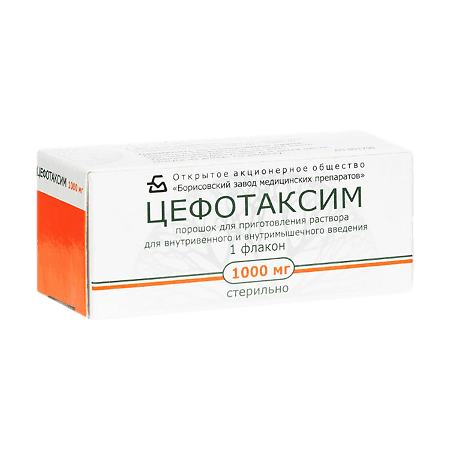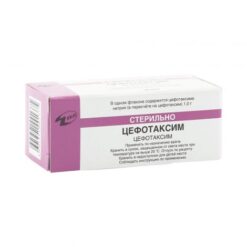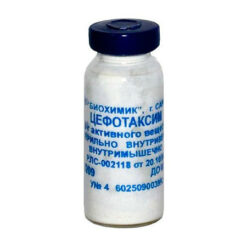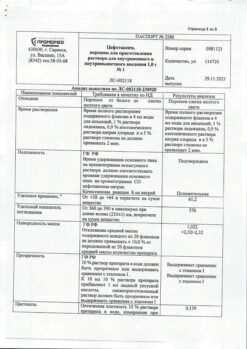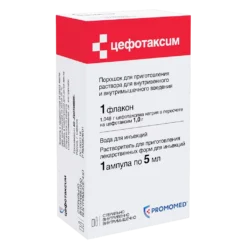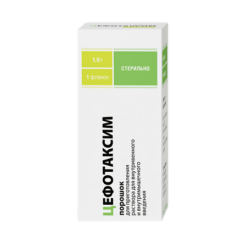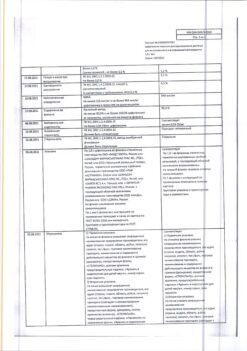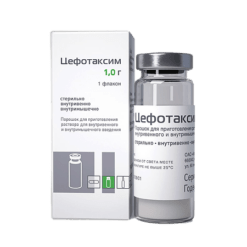No products in the cart.
Cefotaxime, 1 g
€1.00
Out of stock
(E-mail when Stock is available)
Description
Pharmacotherapeutic group: Antibiotic-cephalosporin
ATC code: J01DD01
Pharmacodynamics:
Third generation cephalosporin antibiotic for parenteral administration. It has bactericidal effect by disrupting synthesis of cell wall of microorganisms. It has a broad spectrum of action.
Cefotaxime is usually sensitive to: Aeromonas hydrophila; Bacillus subtilis; Bordetella pertussis; Borrelia burgdorferi; Moraxella catarrhalis; Citrobacrer diversus; Curobacler freundii*; Clostridium perfringens; Corynebacterium diphtheriae Escherichia coli; Enterobacter spp.*; Erysipelothrix insidiosa; Eubacterium spp.; Haemophilus spp. (penicillinase-producing and non-producing strains including ampicillin-resistant strains): Klebsiella pneumoniae; Klebsiella oxytoca; Staphylococcus spp. (methicillin-sensitive including penicillinase-producing and non-penicillinase-producing strains); Morganella morganii Neisseria gonorrhoea (including penicillinase-producing and non-producing strains); Neisseria meningitidis: Propionibacterium spp ; Proteus mirabilis; Proteus vulgaris: Providencia spp.Streptococcus spp (including Streptococcus pneumoniae): Salmonella spp. Serratia spp* ; Shigella spp. Veillonella spp*; Yersinia spp*; Pseudomonas spp. (except Pseudomonas aeruginosa Pseudomonas cepacia).
* – sensitivity depends on epidemiological data and the level of resistance in each particular country.
Cefotaxime is resistant to: Acinetobacter baumanii; Bacteroidcs fragilis; Clostridium difficile; Entcrococcus spp.; Gram-negative anaerobes: Listeria monocytogenes Staphylococcus spp. (methicillin-resistant strains); Pseudomonas aeruginosa; Pscudomonas cepacia; Stenotrophomonas maltophilia.
Pharmacokinetics:
After single v/v (intravenous) administration in doses 05 1 and 2 g time to reach maximum concentration (TSmax) – 5 min maximum concentration (Cmax) is 39 1017 and 214 µg/ml respectively. After intramuscular (intramuscular) administration of 05 and 1 g doses, the TCmax is 05 h and the Cmax is 11 and 21 mcg/ml, respectively. Binding with plasma proteins is 30 – 50%. Bioavailability – 90 – 95%.
Creates therapeutic concentrations in most tissues (myocardium bone tissue gallbladder skin soft tissue) and fluids (synovial pericardial pleural sputum bile urine cerebrospinal fluid (CSF) of the body. The volume of distribution – 025 – 039 l/kg.
Half-life period (T1/2) – 1 hour in infusion and 1-1.5 hours – when administered intravenously. It is excreted by kidneys – 20-36 % unchanged, the rest – as metabolites (15-25 % as pharmacologically active deacetylcephotaxime and 20-25 % – as two inactive metabolites M2 and MH).
In chronic renal insufficiency and elderly patients T1/2 is twice longer. In neonates T1/2 is from 0.75 to 15 h in premature infants increases to 64 h.
Indications
Indications
Active ingredient
Active ingredient
Composition
Composition
How to take, the dosage
How to take, the dosage
Interaction
Interaction
Special Instructions
Special Instructions
Contraindications
Contraindications
Side effects
Side effects
Classification of adverse reactions according to World Health Organization guidelines: very common (> 10%): common (> 1% < 10%); infrequent (> 0.1% and < 1%); rare (> 001% and < 0L%); very rare (< 001%); frequency unknown (the frequency of side effects cannot be estimated from the available data).
Infectious and parasitic diseases
Frequency unknown: superinfections. As with the administration of other antibiotics, the use of cefotaxime especially long-term may lead to an overgrowth of insensitive microorganisms. The patient’s condition should be monitored regularly If superinfection develops during therapy with cefotaxime appropriate measures should be taken.
Blood and lymphatic system disorders
Infrequent: leukopenia eosinophilia thrombocytopenia.
Prevalence unknown: insufficiency of medullary hematopoiesis pancytopenia neutropenia agranulocytosis hemolytic anemia.
Immune system disorders
Infrequent: Jarisch-Herkeheimer reaction.a As with the use of other antibiotics in the treatment of borreliosis during the first days of therapy, development of Jarisch-Herkeheimer reaction is possible. There are reports of one or more symptoms occurring after a few weeks of treatment with borreliosis: skin rash itching fever leukopenia increased “liver” enzyme activity difficult breathing discomfort in the joints. Keep in mind that to some degree these manifestations are consistent with the symptoms of the underlying disease for which the patient is receiving treatment.
Prevalence unknown: anaphylactic reactions angioedema bronchospasm anaphylactic shock.
Nervous system disorders
Infrequent: seizures.
Prevalence unknown encephalopathy (e.g. impaired consciousness impaired motor activity) headache dizziness.
Cardiac disorders
Prevalence unknown: arrhythmias (due to rapid bolus injection via central venous catheter).
Gastrointestinal tract disorders
Infrequent: diarrhea
Infrequent unknown: nausea vomiting abdominal pain pseudomembranous colitis
Liver and biliary tract disorders
Infrequent: Increased activity of “hepatic” enzymes (alanine aminotransferase (ALT) aspartate aminotransferase (ACT) lactate dehydrogenase (LDH) gamma-glutamyltransferase (gamma-GT) alkaline phosphatase (ALP) and/or bilirubin concentrations. These abnormal laboratory values (which can also be explained by the presence of infection) rarely exceed the upper limit of the norm by a factor of 2 and indicate liver damage manifested by cholestasis and often asymptomatic.
Prevalence unknown: hepatitis (sometimes with jaundice).
Skin and subcutaneous tissue disorders
Infrequent: rash pruritus urticaria.
Prevalence unknown: erythema multiforme Stevens-Johnson syndrome toxic epidermal necrolysis acute generalized exanthematous pustulosis.
Renal and urinary tract disorders
Infrequent: decreased renal function increased concentration of creatinine especially when combined with aminoglycosides.
Prevalence unknown: acute renal failure interstitial nephritis.
General disorders and disorders at the injection site
Often: pain at the injection site (when administered intramuscularly).
Infrequent: fever inflammatory reactions at the injection site including phlebitis/thrombophlebitis.
Prevalence unknown: In intramuscular injection if lidocaine is used as a solvent, systemic reactions associated with lidocaine may develop especially in cases of inadvertent intravenous injection of the drug injection into highly vascularized tissues or in overdose.
Overdose
Overdose
Pregnancy use
Pregnancy use
Similarities
Similarities
Additional information
| Weight | 0.040 kg |
|---|---|
| Shelf life | 2 years. It is recommended to use up to the period specified on the package. |
| Conditions of storage | In the dark place at a temperature not more than 25 ° C. Freshly prepared solution is suitable for use for 12 hours at a room temperature not more than 25 ° C. Keep out of reach of children. |
| Manufacturer | Borisov Medical Preparations Plant, Belarus |
| Medication form | Powder for preparation of solution |
| Brand | Borisov Medical Preparations Plant |
Other forms…
Related products
Buy Cefotaxime, 1 g with delivery to USA, UK, Europe and over 120 other countries.

